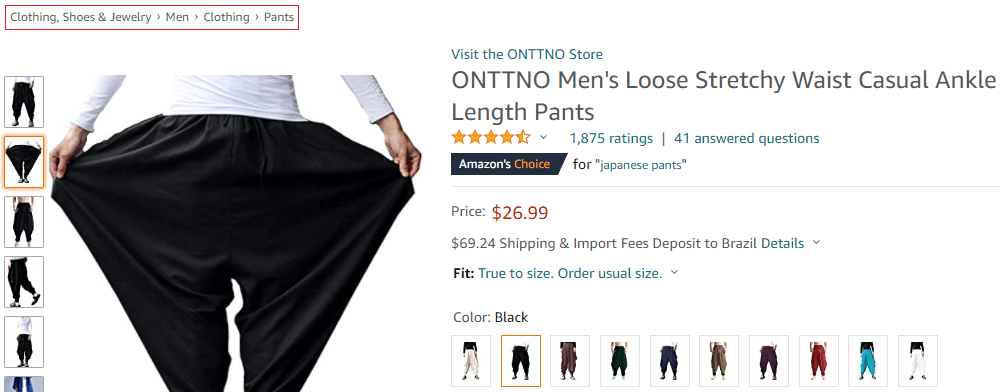Take a moment to think about the classic children’s story, Hansel and Gretel.
In the text, two children are lost in a forest and they attempt to use tiny bits of bread as markers to find their way home.
While the story itself is intensely dark and not really as entertaining once you reach adulthood, it does lend itself to the meaning behind a popular web navigation feature — appropriately named breadcrumbs.
When it comes to working out your technical search engine optimization (SEO), breadcrumbs can be a handy way for visitors to find their way around your website more effectively.
In this guide, we’ll go over what they are and how they can improve your search ranking. Plus, we’ll talk about a couple of simple ways to add them to your website.
No fairy tales here. Just helpful information. Ready to dive in?
What Are Breadcrumbs in SEO?
A breadcrumb is a text path listed at the top of a page that explains where in the navigation of the website a visitor is at.
Usually, these are more commonly found with eCommerce stores. However, they can also be on other pages that have a large amount of content or evergreen pages.
More importantly, they also appear in Google search results.
When someone sees your page pop up in the SERPs, they’ll understand that it is part of a bigger navigation structure that might include just what they’re looking to find.
Not all website templates come equipped with breadcrumbs, but it is certainly an important addition to your page if you’re wanting to improve SEO and promote a positive user experience.
Think of it as your way of giving your visitors the guidance they need while making it easier to find their way back to your homepage without having to click the back button.

What Are the Types of Breadcrumbs?
Now, it is important to understand that there are varying types of breadcrumbs. No, we’re not talking pumpernickel versus sourdough or anything like that.
The three most common types of technical breadcrumbs you’ll find are classified as:
Hierarchy-based breadcrumbs
Hierarchy-based breadcrumbs show the page you’re viewing as a piece of the overall website structure.
This does not change, no matter where the user came from prior or where they’re going after. It remains static.
This is usually common for websites with tons of content and not necessarily eCommerce stores.
Attribute-based breadcrumbs
Attribute-based breadcrumbs follow when someone has searched a website for a particular item with specific attributes, like size, brand, or color.
This is essentially a variable breadcrumb structure, as it will be different for each individual user based on what they’ve typed into the search form.
History-based breadcrumbs
History-based breadcrumbs show a user where they’ve been previous to the page they’re on.
While it is a variable structure in that it depends on a user’s natural journey through pages on the website, it is a lot more static than an attribute-based structure.
How do you know which type to use on your page?
Really, it comes down to the type of content you’re offering and whether someone might need to look up specific keywords or tags to find the page they’re looking for.
If you have thousands of products with multiple color or style options, then you’ll want an attribute-based style.
But if you just have a few evergreen pages on your website, then something as simple as a hierarchy-based breadcrumb structure is more than sufficient.
The SEO Benefits of Using Breadcrumbs
We already know that it is a good idea to use breadcrumbs to increase your overall website user experience. But that isn’t all.
In fact, Google loves breadcrumbs for the sole reason that it gives crawlers a better understanding of what your page is about and the hierarchy of your website.
Additionally, they also decrease bounce rates, which can affect your SEO.
When a person comes to your page from the SERPs and knows it is easy to navigate to the information they’re looking for, then they’re less likely to click away.
A longer on-page time equates to better data for you and a chance at an improved rank position overall.
In short, breadcrumbs provide better navigation for both web crawlers and the human visitors who come to your page. It’s a win-win for everyone.
Breadcrumb SEO Best Practices
Unfortunately, creating these navigational nuggets to improve your search engine ranking is about more than just including them on your website.
Here are a few breadcrumb SEO best practices to consider:
Use the Right Font Size
You don’t want your breadcrumbs to be so microscopic that your users can’t see them, but you also don’t want them to be too obtrusive to the overall visual layout of your page.
Instead, take a page out of another popular fairytale character — Goldilocks — and keep them just right.

Don’t Go Overboard with Too Many Breadcrumbs
Your breadcrumbs need to match your overall site structure.
If you’re using too many, that can be confusing to both Google and your users.
Instead, opt for ones that make the most sense and enhance the overall user experience of your page.
Don’t Just Repeat Your Navigation or Skip the Navigation
Another tip?
Don’t just repeat your navigation or eliminate a navigation bar altogether in favor of breadcrumbs.
Users don’t always want to have to stay within the structure of the breadcrumb path and would rather jump around with a traditional navigation bar. Keep this in place.
Keep it Simple
Breadcrumbs are meant to make the overall process of navigating from one section of the website to another a simple affair.
Don’t get too complicated with it!
Instead, keep things simple and follow a logical path. By doing this, you make it less likely that your visitors will get frustrated and go elsewhere for the right answers.
Make Breadcrumbs Easy to Spot
If you’re going to go through the trouble of adding breadcrumbs, at least make them easy for the user to spot.
The most common position is at the top of the page, below the navigation bar.
However, there might be other areas that would make the most sense based on your unique visual layout.
Easy Ways to Add Breadcrumbs in WordPress
While it might seem like breadcrumbs SEO is one of the more difficult aspects of technical optimization, the truth is that it is a lot easier than it looks.
If your website is a WordPress page, then there are plenty of plugins to help you add the right navigation and structured data markup for Google automatically to your page.
Those on eCommerce platforms like Shopify or BigCommerce can turn the feature on with just a click on your dashboard.
But what if your page is custom or not listed on any of those options?
You do have the choice to add breadcrumbs the old-fashioned way with some markup text, but you might want to contact a professional agency for advice on how to make this happen without crashing your coding altogether.
How Do You Get Breadcrumbs to Show Up in Your Google Search Results?
To get breadcrumbs to show up on your listings in the SERPs, you’ll need a bit of markup text.
Usually, this feature is included in whichever plugin you choose to add the feature to your website.
If not, a bit of extra coding can get the job done — which, again, you would want to contact someone familiar with this process to guide you on how to do it for your unique page.
Wrap Up: Using Breadcrumbs to Improve SEO
There are many reasons to use breadcrumbs to benefit your SEO strategy.
Not only is it good practice for upgrading UX and reducing bounce time, but it also gives search engines like Google a road map for finding their way around your site structure.
Are you interested in learning about other technical SEO best practices that can help you improve your search engine ranking?
Check out our step-by-step guide on how to use technical SEO to leverage your rankings!
2024 State of Marketing Report
Your golden ticket to crush your goals with data-driven insights!
2024 State of Marketing Report
Your golden ticket to crush your goals with data-driven insights!

![[WA] Ultimate Content Marketing Kit](https://rockcontent.com/wp-content/uploads/2022/08/Content-Marketing-Kit-750x200px.jpg)
![[Rock NA] State of Marketing Reports 2024 – Comkt Hubspot State of Marketing Report 2024](https://rockcontent.com/wp-content/uploads/2022/07/Banner-Fino-Rock-Convert-2500-%C3%97-500-px-19.png)








